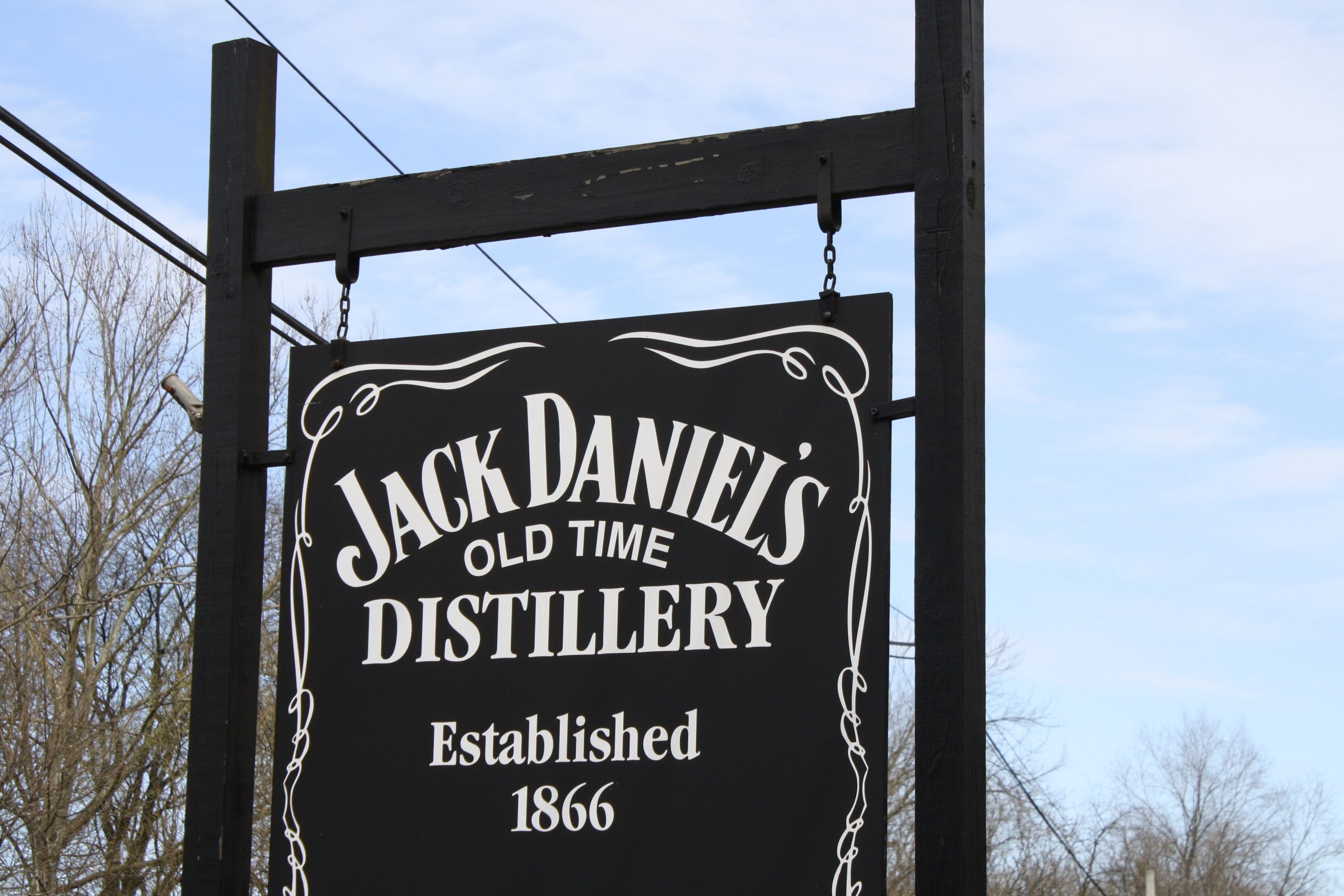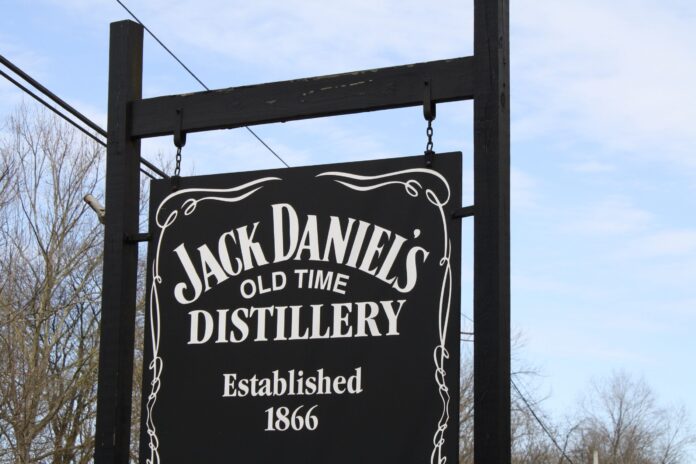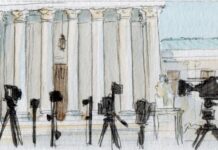OPINION ANALYSIS
on Jun 9, 2023
at 11:20 am

The entrance to the Jack Daniel’s distillery in Lynchburg, Tenn. (Tarheel1776 via Shutterstock)
Thursday’s decision in Jack Daniel’s Properties v. VIP Products firmly rejected the use of the Jack Daniel’s trademarks by a manufacturer selling a line of dog toys that mock various beverage manufacturers. The one at issue here copies numerous elements of the famous Jack Daniel’s bottle. In the words of Justice Elena Kagan:
- The toy “is about the same size and shape as an ordinary bottle of Jack Daniel’sâ€;
- The “faux bottle†follows the original in using a “black label with stylized white text and a white filigreed borderâ€;
- The toy has the product name (Bad Spaniels) “in a like font and arch†to those of the Jack Daniel’s bottle; and
- “Old No. 2 On Your Tennessee Carpet†replaces “Old No. 7 Tennessee Sour Mash Whiskey.â€
All members of the court joined Kagan’s opinion finding that toy a condemnable infringement of the Jack Daniel’s marks.
Kagan rests her analysis on two basic points of trademark law, summarized emphatically at the beginning and reiterated at the end of her opinion. First, the basic purpose of a trademark is to “identif[y] a product’s source (this is a Nike) and distinguis[h] that source from others (not any other sneaker brand).†Second, the central purpose of the cause of action for trademark infringement in the federal Lanham Act is confusion, specifically, confusion “about the source of a product or service.†She quips: “Confusion as to source is the bête noire of trademark law – the thing that stands directly opposed to the law’s twin goals of facilitating consumers’ choice and protecting producers’ good will,†both of which depend on a reliable identification of the source of products.

The Jack Daniel’s bottle next to the VIP Products “Bad Spaniels†dog toy.
Kagan’s treatment of the dispute flows directly from that foundation. First, for her the most important feature of the Bad Spaniels toy is the purpose for which it uses the Jack Daniel’s marks, “as a designation of source for [its] own goods.†Whatever protections parodies might have in other contexts, Kagan reasons that there can be no special First Amendment defense when the copied mark is used in that way.
She spends several pages – more than a third of the entire opinion – discussing the 1989 ruling in Rogers v. Grimaldi, in which the U.S. Court of Appeals for the 2nd Circuit rejected the effort of legendary movie star and dancer Ginger Rogers to block the use of the title “Ginger and Fred†by a movie about two fictional Italian cabaret performers. The lower court in this case thought that Rogers gave the dog toy a free pass because of the “communicative†aspects of the toy. The Supreme Court has not directly embraced (or rejected) Rogers, but Kagan rejects the lower court’s treatment of it as completely out of step with the way other courts have understood it. In her view, the many “lower courts adopting a First Amendment defense based on Rogers†have (except in this case) never applied it to cases “in which a trademark is used … to designate a work’s source.†Rather, they have “confined it to … case[s] in which a trademark is used to perform some other expressive function.â€
She offers the memorable example of the “Barbie Girl†song, which Mattel (the owner of Barbie trademarks) could not block because “Barbie Girl†did not suggest that the song was by Mattel: “[A] consumer would no more think that the song was produced by Mattel†than they would think that Janis Joplin and Mercedes Benz had “entered into a joint venture†when they heard “Janis Joplin croon ‘Oh Lord, won’t you buy me a Mercedes Benz?’†Summarizing her perspective, Kagan concludes that “whatever you make of Rogers — and … we take no position on that … — it has always been a cabined doctrine,†limited to products that use the mark in a “non-source-identifying way.â€
Having set that boundary on any defense based on Rogers or the First Amendment, Kagan reminds us that she has drawn that boundary from the doctrinal foundation she used to start her opinion. Circling back to that foundation, she quotes a leading treatise’s description of the central function of trademarks: “to indicate the source of goods, and so to distinguish them from ones manufactured or sold by others.†For readers who can’t remember the “bête noire†of trademark from the opening pages of the opinion, she emphasizes that “[t]he cardinal sin under the law … is to undermine†the ability reliably to indicate the source of goods, and reasons that “confusion is most likely to arise when someone uses another’s trademark as a trademark … rather than for some other expressive function.†For the justices, the lower court was profoundly “mistaken to believe that the First Amendment demanded†protection for such a use. “When a mark is used as a mark,†the “interest in free expression†gets all the protection it needs by requiring the trademark owner to prove a likelihood of confusion.
The opinion closes with a brief rejection of a separate statutory ruling protecting the toy under a federal statute that prevents uses that “dilute†trademarks like those of Jack Daniel’s. That statute has an exception that protects competing uses if their use of the mark is “noncommercial.†The lower court here treated the use as “noncommercial†because it “parodies†and “convey[s] a humorous message†about Jack Daniel’s. Kagan finds that reading of the statute untenable, because the statute’s protection for fair use is limited, explicitly, so that it does not apply for use “as a designation of source for the person’s own goods or services.†Echoing the analysis in the main part of her opinion (about the Lanham Act), Kagan reasons that Congress’s explicit statutory rejection of any protection use “as a designation of source†means that the use in question here – squarely within that category – cannot be protected from a suit by the trademark holder Jack Daniel’s.
The Supreme Court does not often decide cases focusing on core issues of trademark law, so the vigorous discussion of the importance of confusion here likely will be considered frequently by lower courts and in detail by scholars. For the observer, perhaps the most notable thing about the opinion is the muscular tone. As in other major intellectual property cases this term – Andy Warhol Foundation for the Visual Arts, Inc. v. Goldsmith for copyrights and Amgen Inc. v. Sanofi for patents come to mind – the Jack Daniel’s court is much more assertive than it usually is in this area in offering bold and unqualified basic principles as a basis for its decision. In past years the justices often wrote with such a hesitant and guarded tone that lower courts and scholars would be frustrated in trying to discern any clear line of decision in the court’s reasoning. That is not a problem with the central intellectual property cases of this term.





